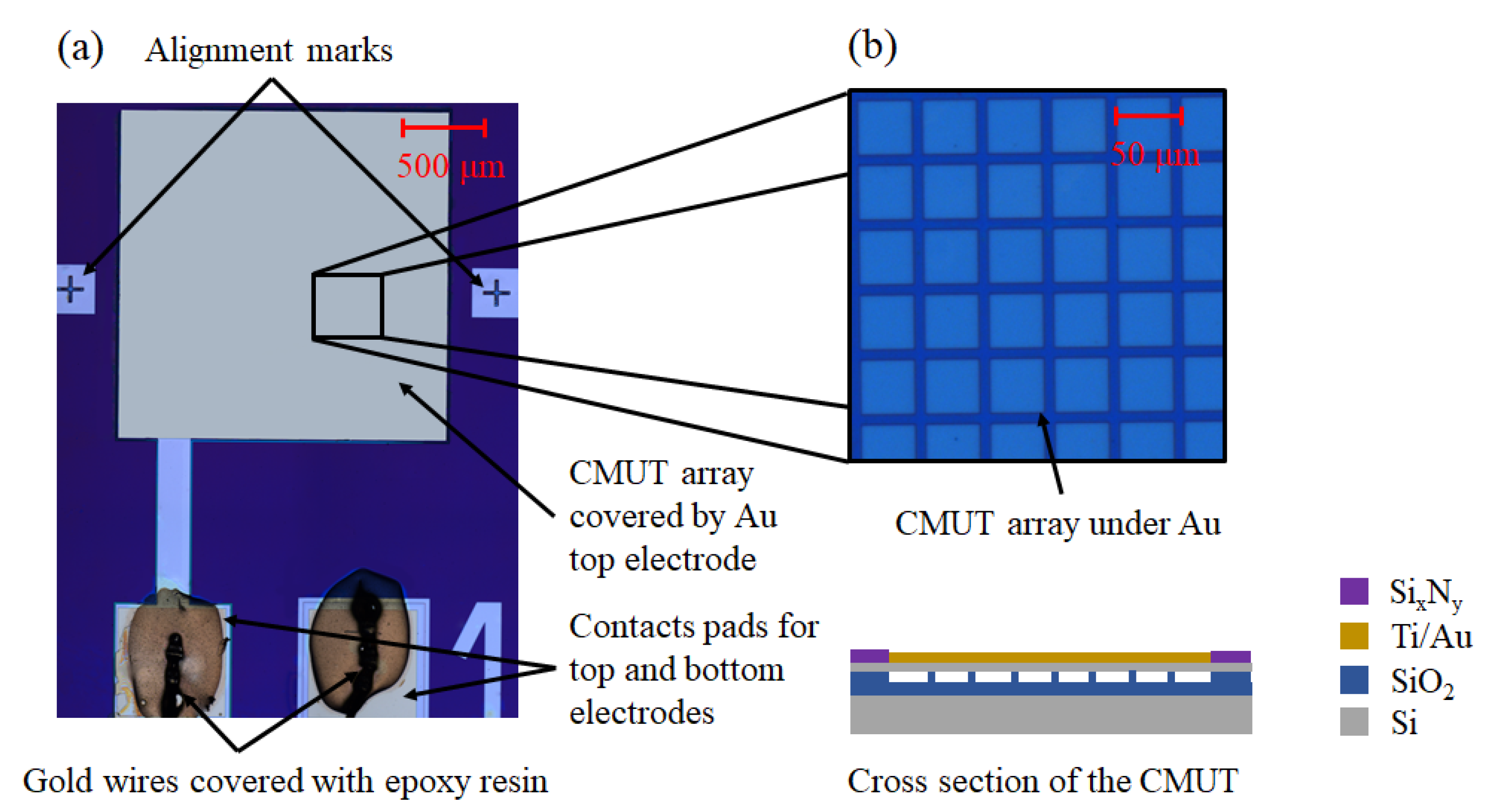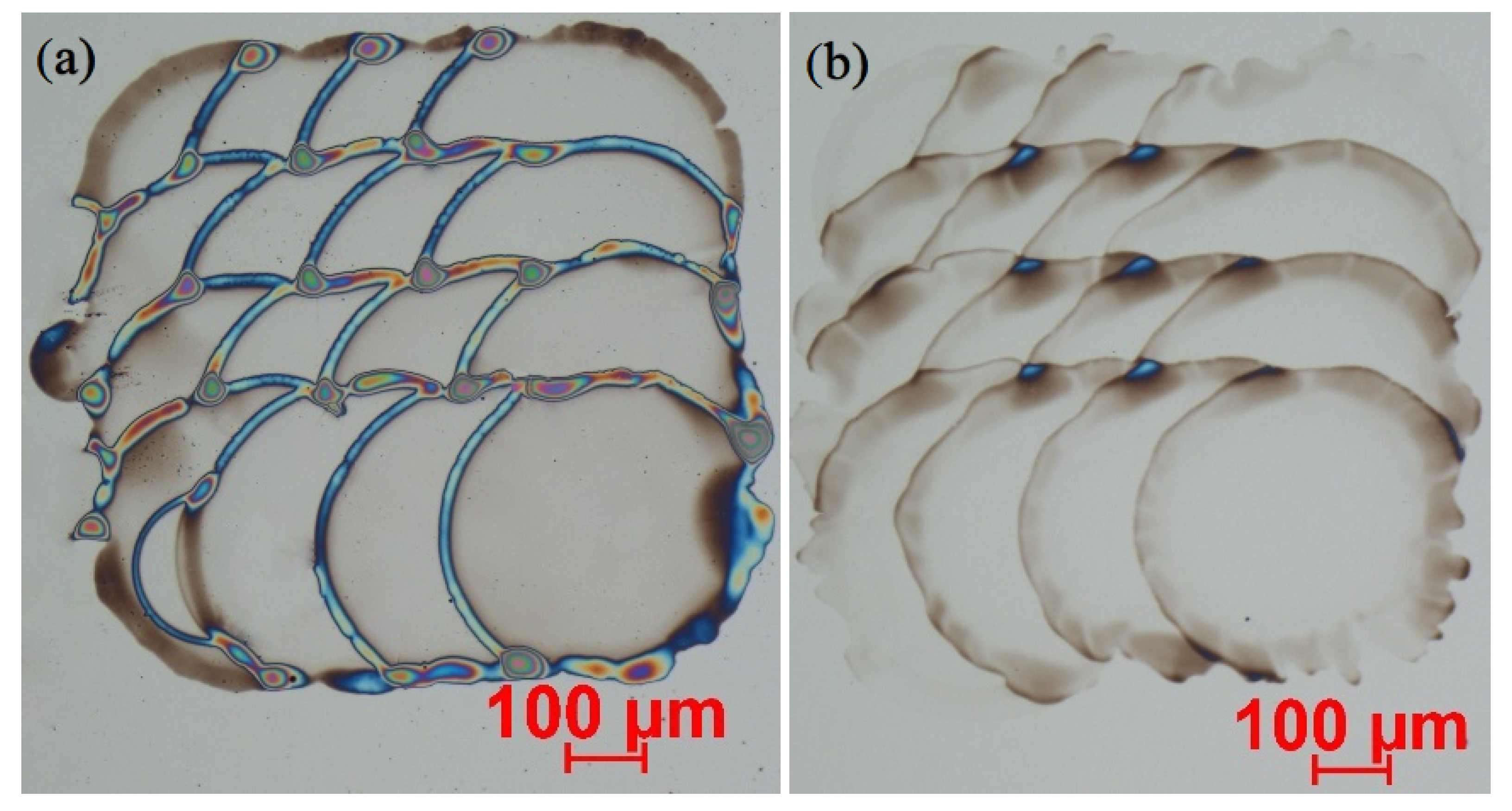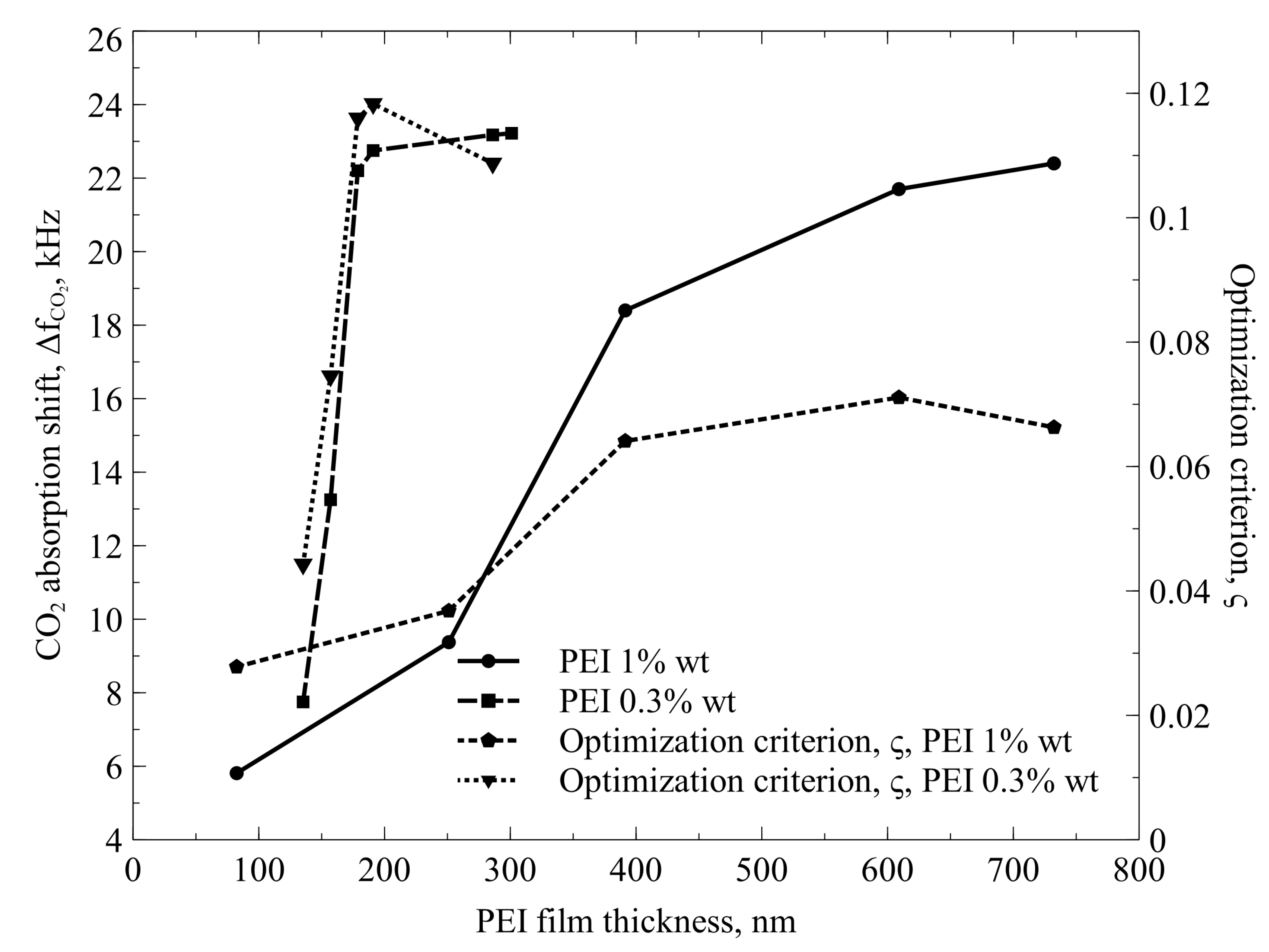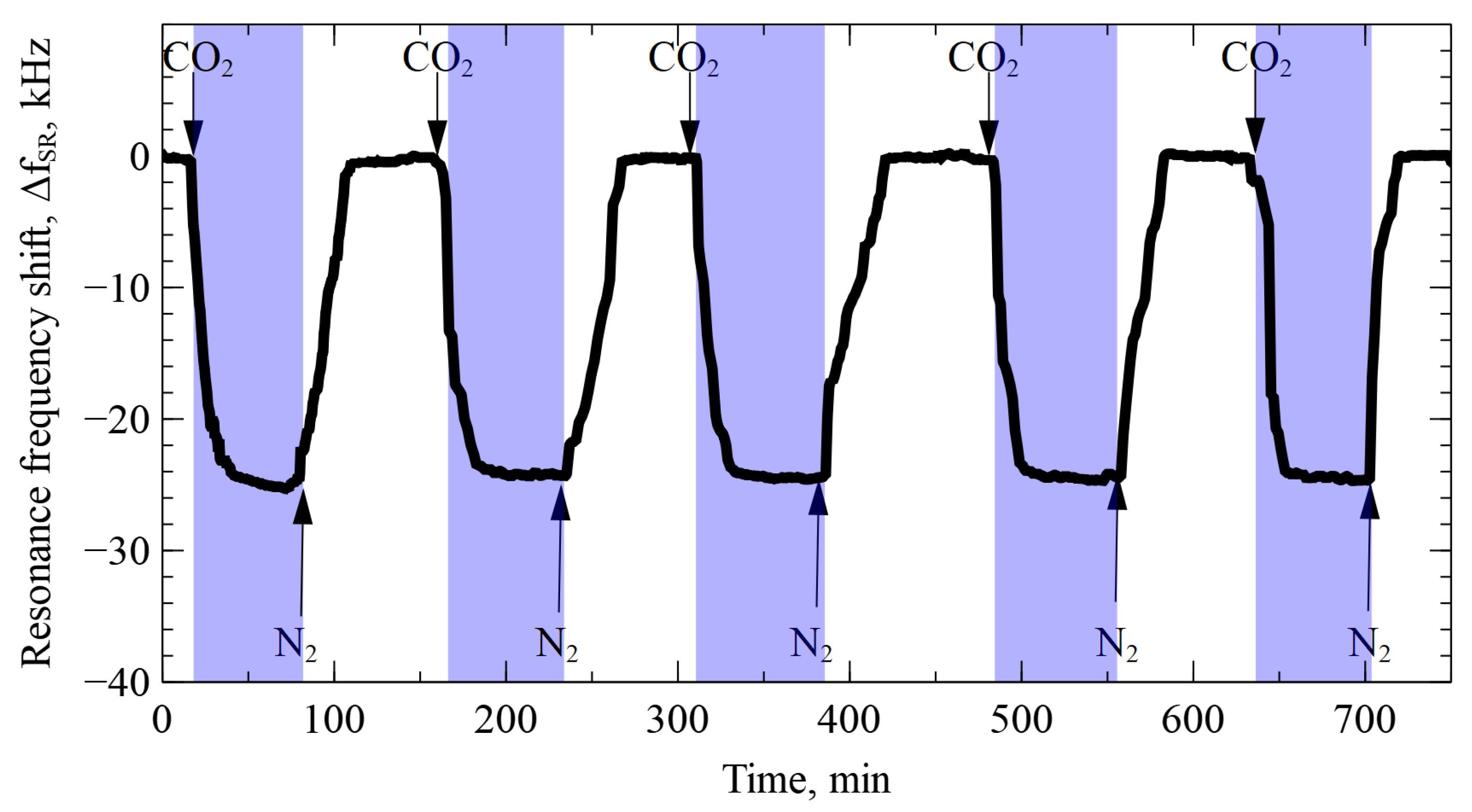Inkjet-Printed Functionalization of CMUT-Based CO2 Sensors
Abstract
:1. Introduction
2. Materials and Methods
2.1. Functional Material and Thickness Control
2.2. Inkjet Printing Technique
- Dehydration bake—surface activation by dehydration bake was completed on a KarlSuus (Germany, Gmbh) hot plate at 220 °C kept for 60 min.
- Treatment with HMDS—surface activation by HMDS was completed in a two-step process: firstly, the samples were dehydration baked at 220 °C for 60 min, and then, a thin layer of HMDS primer was spin coated at 2000 rpm for 60 s.
- O2 plasma cleaning and activation—samples were loaded into an Advanced Vacuum reactive ion etching system Vision 320 RIE, where they were subject to oxygen plasma with power of 80 W with O2 flow of 40 sccm in 30 mTorr pressure for 60 s.
2.3. CMUT Design, Fabrication, and Testing
2.4. Optimization of the Printed PEI Thickness
3. Results
3.1. Thickness and Morphology of the Inkjet-Printed PEI Coatings
3.2. Functional Film Thickness Measurement through Light Interferometry and AFM Data
3.3. Functionalization and CO2 Sensitivity Tests
4. Discussion and Conclusions
Author Contributions
Funding
Institutional Review Board Statement
Informed Consent Statement
Acknowledgments
Conflicts of Interest
References
- Lynch, J.; Cain, M.; Frame, D.; Pierrehumbert, R. Agriculture’s Contribution to Climate Change and Role in Mitigation Is Distinct From Predominantly Fossil CO2-Emitting Sectors. Front. Sustain. Food Syst. 2021, 4, 518039. [Google Scholar] [CrossRef]
- Lamb, W.F.; Wiedmann, T.; Pongratz, J.; Andrew, R.; Crippa, M.; Olivier, J.G.; Wiedenhofer, D.; Mattioli, G.; Al Khourdajie, A.; House, J.; et al. A review of trends and drivers of greenhouse gas emissions by sector from 1990 to 2018. Environ. Res. Lett. 2021, 16, 073005. [Google Scholar] [CrossRef]
- Asri, M.I.A.; Hasan, M.N.; Fuaad, M.R.A.; Yunos, Y.M.; Ali, M.S.M. MEMS Gas Sensors: A Review. IEEE Sensors J. 2021, 21, 18381–18397. [Google Scholar] [CrossRef]
- Jia, H.; Xu, P.; Li, X. Integrated Resonant Micro/Nano Gravimetric Sensors for Bio/Chemical Detection in Air and Liquid. Micromachines 2021, 12, 645. [Google Scholar] [CrossRef] [PubMed]
- Barauskas, D.; Dzikaras, M.; Bieliauskas, D.; Pelenis, D.; Vanagas, G.; Viržonis, D. Selective Ultrasonic Gravimetric Sensors Based on Capacitive Micromachined Ultrasound Transducer Structure—A Review. Sensors 2020, 20, 3554. [Google Scholar] [CrossRef] [PubMed]
- Lee, H.J.; Park, K.K.; Kupnik, M.; Melosh, N.A.; Khuri-Yakub, B.T. Mesoporous Thin-Film on Highly-Sensitive Resonant Chemical Sensor for Relative Humidity and CO2 Detection. Anal. Chem. 2012, 84, 3063–3066. [Google Scholar] [CrossRef] [PubMed]
- Lee, H.J.; Park, K.K.; Kupnik, M.; Khuri-Yakub, B.T. Functionalization layers for CO2 sensing using capacitive micromachined ultrasonic transducers. Sens. Actuators B Chem. 2012, 174, 87–93. [Google Scholar] [CrossRef]
- Mølgaard, M.J.G.; Laustsen, M.; Jakobsen, M.H.; Andresen, T.L.; Thomsen, E.V. Combined colorimetric and gravimetric CMUT sensor for detection of benzyl methyl ketone. Sens. Actuators B Chem. 2018, 275, 483–489. [Google Scholar] [CrossRef]
- Zheng, Z.; Kim, N.; Wong, W.S.; Yeow, J.T.W. Inkjet-printed CMUT humidity sensors with high sensitivity and low hysteresis. Sens. Actuators B Chem. 2021, 327, 128920. [Google Scholar] [CrossRef]
- Zheng, Z.; Tang, C.; Yeow, J.T. A high-performance CMUT humidity sensor based on cellulose nanocrystal sensing film. Sens. Actuators B Chem. 2020, 320, 128596. [Google Scholar] [CrossRef]
- Barauskas, D.; Park, S.J.; Pelenis, D.; Vanagas, G.; Lee, J.J.; Viržonis, D.; Jones, C.W.; Baltrusaitis, J. CO2 and SO2 Interactions with Methylated Poly(ethylenimine)-Functionalized Capacitive Micromachined Ultrasonic Transducers (CMUTs): Gas Sensing and Degradation Mechanism. Acs Appl. Electron. Mater. 2019, 1, 1150–1161. [Google Scholar] [CrossRef]
- Barauskas, D.; Pelenis, D.; Vanagas, G.; Viržonis, D.; Baltrušaitis, J. Methylated Poly(ethylene)imine Modified Capacitive Micromachined Ultrasonic Transducer for Measurements of CO2 and SO2 in Their Mixtures. Sensors 2019, 19, 3236. [Google Scholar] [CrossRef] [PubMed] [Green Version]
- Barauskas, D.; Pelenis, D.; Virzonis, D.; Baltrus, J.P.; Baltrusaitis, J. Greenhouse gas molecule CO2 detection using a capacitive micromachined ultrasound transducer. Anal. Chem. 2016, 88, 6662–6665. [Google Scholar] [CrossRef] [PubMed] [Green Version]
- Zheng, Z.; Yao, Y.; Liu, J.A.; Sun, Y.; Yeow, J.T. Highly sensitive CMUT-based humidity sensors built with nitride-to-oxide wafer bonding technology. Sens. Actuators B Chem. 2019, 294, 123–131. [Google Scholar] [CrossRef]
- Lau, G.K.; Shrestha, M. Ink-jet printing of micro-electro-mechanical systems (MEMS). Micromachines 2017, 8, 194. [Google Scholar] [CrossRef] [Green Version]










Publisher’s Note: MDPI stays neutral with regard to jurisdictional claims in published maps and institutional affiliations. |
© 2022 by the authors. Licensee MDPI, Basel, Switzerland. This article is an open access article distributed under the terms and conditions of the Creative Commons Attribution (CC BY) license (https://creativecommons.org/licenses/by/4.0/).
Share and Cite
Barauskas, D.; Pelenis, D.; Dzikaras, M.; Mikolajunas, M.; Vanagas, G.; Virzonis, D. Inkjet-Printed Functionalization of CMUT-Based CO2 Sensors. Sensors 2022, 22, 2288. https://doi.org/10.3390/s22062288
Barauskas D, Pelenis D, Dzikaras M, Mikolajunas M, Vanagas G, Virzonis D. Inkjet-Printed Functionalization of CMUT-Based CO2 Sensors. Sensors. 2022; 22(6):2288. https://doi.org/10.3390/s22062288
Chicago/Turabian StyleBarauskas, Dovydas, Donatas Pelenis, Mindaugas Dzikaras, Marius Mikolajunas, Gailius Vanagas, and Darius Virzonis. 2022. "Inkjet-Printed Functionalization of CMUT-Based CO2 Sensors" Sensors 22, no. 6: 2288. https://doi.org/10.3390/s22062288
APA StyleBarauskas, D., Pelenis, D., Dzikaras, M., Mikolajunas, M., Vanagas, G., & Virzonis, D. (2022). Inkjet-Printed Functionalization of CMUT-Based CO2 Sensors. Sensors, 22(6), 2288. https://doi.org/10.3390/s22062288




